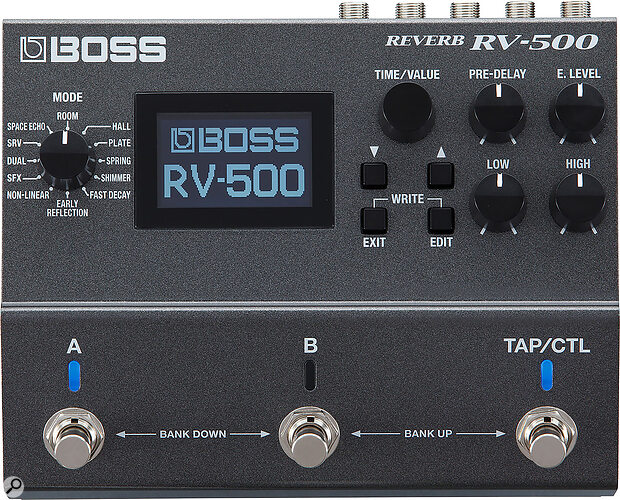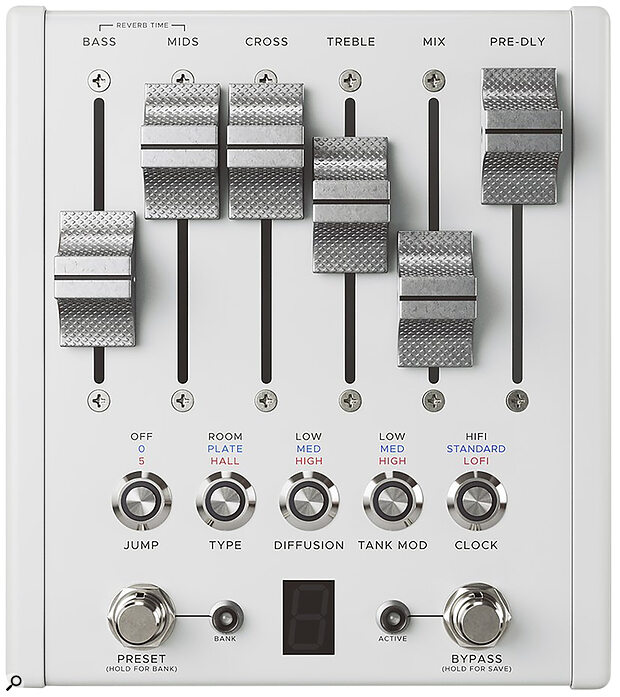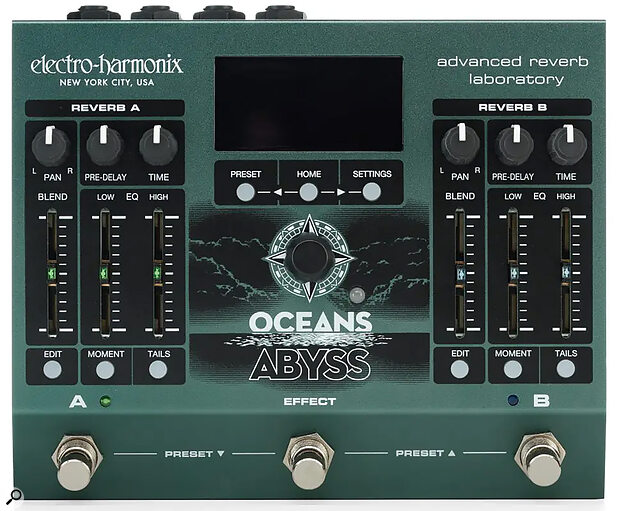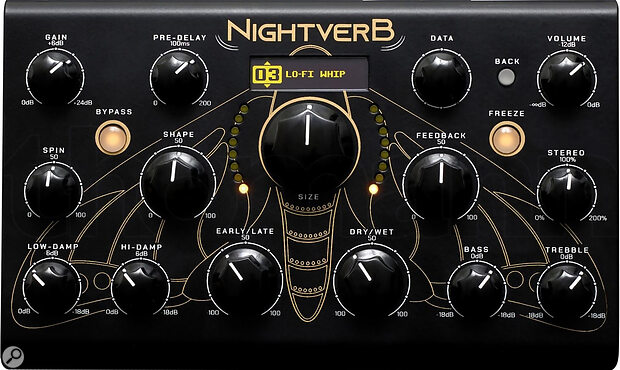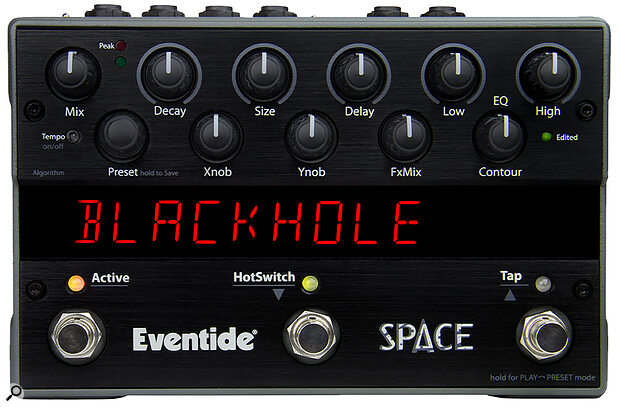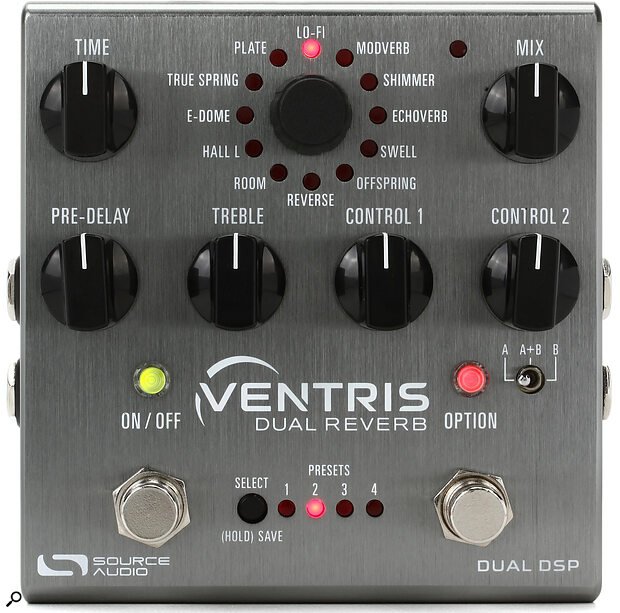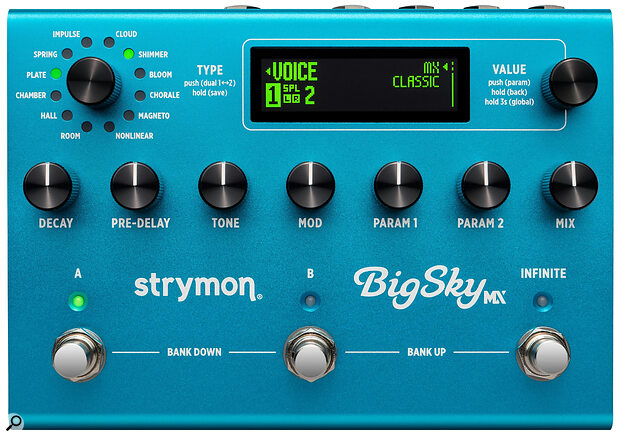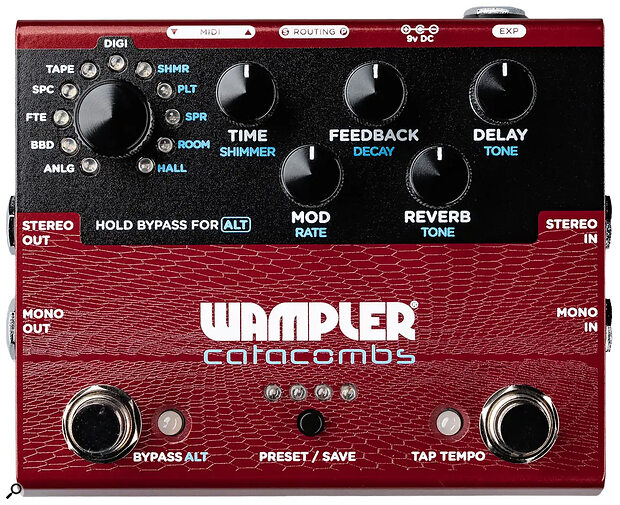In this month’s round‑up, we shine our spotlight on a range of reverb boxes that pack plenty of punch into a pedal format.
Reverb pedals have come a long way over the last decade or so, and there are now plenty of examples that pack in enough serious features to rival their rackmount counterparts. They’re not just aimed at guitarists, either — models that feature plenty of hands‑on controls and have the ability to communicate with other devices using MIDI or CV signals can be a tempting prospect for synth‑based rigs too, and they can even lend themselves to serious mixing use in the studio. This month, we round up a selection of high‑end offerings that are equipped with true stereo signal paths and offer MIDI integration.
Boss RV‑500 & RV‑200
Boss’ flagship RV‑500 comes equipped with 21 reverb algorithms shared across 12 modes, offering everything from spring and plate emulations to huge‑sounding atmospheric soundscapes, as well as some classic Roland effects including the SRV‑2000 Digital Reverb and RE‑201 Space Echo. The pedal boasts 32‑bit/96kHz processing, and packs in enough DSP to provide independent delay and modulation along with every reverb patch, as well as allowing users to run two of its reverb algorithms simultaneously — the Dual mode offers series and parallel routing options, as well as allowing each reverb to be fed with a full‑range or band‑split signal. Top‑panel controls are provided for key parameters, and a rear‑panel TRS socket supports the connection of two additional footswitches or an expression pedal. MIDI I/O is provided on five‑pin DIN connectors as well as USB, and the latter can be used to carry out remote editing and patch backup from a computer using the free RV‑500 Editor/Librarian software.
Boss also offer the RV‑200, a more compact pedal with 12 reverb modes and a more streamlined feature set. You still get stereo I/O and footswitch/expression pedal connectivity, but there are fewer onboard presets (127 compared to the RV‑500’s 297), and the smaller footprint means the MIDI I/O is on 3.5mm TRS mini‑jack sockets. Both pedals have the ability to maintain reverb tails when switching between presets or bypassing the effect.
www.soundonsound.com/reviews/boss-rv-500
www.soundonsound.com/reviews/boss-rv-200-reverb
RV‑500 £379, RV‑200 £259. Prices include VAT.
www.boss.info/us/products/rv-500
www.boss.info/us/products/rv-200
RV‑500 $439.99, RV‑200 $296.99
www.boss.info/us/products/rv-500
www.boss.info/us/products/rv-200
Chase Bliss Audio CXM 1978
Built in collaboration with Meris, the CXM 1978 offers Chase Bliss Audio’s take on the revered Lexicon 224 rackmount reverb and its iconic LARC remote controller. Room, Plate and Hall modes are available, while a Tank Mod button provides a choice of Low, Med and High settings that apply increasing amounts of modulation to the signal, allowing users to craft a range of chorus and rotary speaker‑inspired effects. Individual reverb time controls are provided for low‑end and midrange frequencies, with the split point defined by a Cross control, while a Diffusion switch offers a choice of three settings that affect how much ‘smearing’ is applied to the reverb’s initial attack. A Clock section then includes a Standard mode that replicates the sound of an original 224, along with Lofi and Hifi settings that offer two distinct new takes thanks to decreased/increased bit and sample rates. As for connectivity, a set of six quarter‑inch TRS sockets provide stereo I/O (the pedal will happily accept instrument‑ or line‑level sources), CV and expression pedal connectivity, and compatibility with the Meris Preset Switch; MIDI in and thru connections are available on five‑pin DIN sockets. The CXM 1978 is capable of storing 30 presets, and benefits from motorised faders that respond to patch changes or external control signals.
www.soundonsound.com/reviews/chase-bliss-audio-cxm-1978
€1069 including VAT.
$899
Electro‑Harmonix Oceans Abyss
Described as an “advanced reverb laboratory”, the Oceans Abyss from Electo‑Harmonix comes loaded with 10 reverb types, any two of which can be run simultaneously thanks to its dual effects engine. It features a flexible signal path that can be configured with up to eight effects blocks — two are dedicated to reverb, while the remaining slots can be loaded with a selection of other modulation, delay, saturation, bit‑crusher and volume‑based effects. Settings are provided to allow reverb tails to be maintained during switching/bypassing. There’s also a stereo effects loop that makes it possible to insert external effects into the pedal’s signal path. Two sets of identical top‑panel knobs and sliders offer hands‑on control over each reverb engine’s key functions, while a footswitch input makes it possible to add up to three external switches, and just about all of the pedal’s parameters can be controlled externally using an expression pedal, CV signals or MIDI CC messages. The audio I/O — which can be instrument‑ or line‑level — footswitch and expression connections are all provided on quarter‑inch TS/TRS jack sockets, while MIDI in and out connections are on five‑pin DIN sockets. There’s also a USB connection that will soon provide editing and preset management using a free EXHport software application.
£475 including VAT.
$495
Empress Effects Reverb
Named simply the Reverb, since Empress Effects’ pedal was released the company have continued to add new reverb algorithms through firmware updates — there are currently 32 algorithms, organised into 12 categories. These cover everything from classic‑sounding halls, plates, springs and rooms to modern ambient and modulated effects. All parameters can be controlled directly from the Reverb’s top panel with no menu‑diving, and it’s possible to store up to 35 presets, which can be navigated and recalled using the pedal’s footswitches. The pedal employs 24‑bit converters, while the internal processing operates at 32‑bit/48kHz. An analogue dry path is blended back with the wet signal using a VCA. True and buffered bypass modes are provided, allowing reverb tails to be preserved, and an isolating transformer on the second output helps to combat ground loops when running a stereo setup with two amps. All of the pedal’s external control functionality is taken care of by a multi‑purpose Universal Control Port connection, which is provided on a rear‑panel quarter‑inch TRS socket. That socket can be used to connect an expression pedal or an external tap‑tempo switch, and it’s capable of receiving CV or MIDI signals, as well as functioning as an external audio input.
£469 including VAT.
$494
Erica Synths Nightverb
The Nightverb from Erica Synths is a bit of an outlier, in that it’s a desktop unit rather than a pedal, but it warrants inclusion here, since it will accept both instrument‑ and line‑level signals and it’s possible to connect an external footswitch. It features a stereo reverb algorithm developed by 112dB and, given the company’s modular synth heritage, it’s no surprise to see the top panel sporting a wealth of hands‑on controls. Decay times range from 1ms all the way to 1000 seconds, and there’s a freeze function that not only allows the reverb tail to be sustained indefinitely, but features chromatic tuning that makes it possible to ‘play’ the frozen sound from a MIDI keyboard. As for external control, all of the parameters can be controlled using MIDI and, as it can also transmit CC messages, the Nightverb can be used to control other gear too. An external footswitch can be used to navigate patches or engage the bypass or freeze functions. The Nightverb comes loaded with 30 factory presets, and includes 70 user memory slots.
€588 including VAT.
$599
Eventide Space
The Eventide Space features 12 distinct reverb types, and comes loaded with 100 factory patches that include a selection of artist presets. There’s a variety of halls, rooms and plates derived from the company’s flagship rackmount processors, along with more experimental offerings such as their Blackhole, MangledVerb and Shimmer algorithms. Plenty of hands‑on control is available thanks to 10 top‑panel knobs, and it’s possible to control the Space’s parameters externally via either an expression pedal or MIDI controller. Instrument‑ and line‑level I/O, expression pedal and Eventide’s Aux Switch connectivity is taken care of by rear‑panel quarter‑inch TS sockets, while MIDI in and out/thru connections are present on five‑pin DIN sockets. Remote editing and preset management can be carried out from a computer using the Eventide Device Manager software application, which can also take full control of the pedal’s parameters.
£439 including VAT.
$499
Meris MercuryX & Mercury7
The first of two offerings from Meris is the Mercury7, which includes Ultraplate and Cathedra algorithms inspired by the Blade Runner soundtrack, along with some pitch‑based processing and modulation capabilities designed with creative, sci‑fi‑style effects in mind. A rear‑panel quarter‑inch TRS socket accepts either an expression pedal or MIDI, both of which can be used to control all of the pedal’s parameters.
The MercuryX steps things up a gear, with five additional algorithms that include the Lexicon‑inspired 78 Room, 78 Plate and 78 Hall, along with Spring, Prism and Gravity modes. There’s a healthy dose of modulation on offer, as well as gate envelope controls for each reverb type and a collection of additional effects including dynamics processors, a selection of preamp models, filters and a range of modulation effects. External control is possible from an expression pedal or over MIDI, the connections for which are provided on separate quarter‑inch TRS and five‑pin DIN sockets. Both pedals feature switchable headroom options that allow them to accommodate instrument‑ and line‑level signals, making them as useful for mixing and live sound as they can be for guitar.
Mercury7 £300, MercuryX £599. Prices include VAT.
Mercury7 $299, Mercury X $599.
Old Blood Noise Endeavors Dark Star
 Old Blood Noise Endeavors Dark Star
Old Blood Noise Endeavors Dark Star
Described as a “soundscape reverb”, Old Blood Noise Endeavors’ Dark Star focuses heavily on dramatic creative effects as opposed to traditional reverbs. Rather than providing multiple algorithms, the pedal allows users to craft a wide range of sounds by augmenting its reverb with a collection of other processors. A pair of independent pitch‑shifters span a ±2 octave range, and there’s a low‑ or high‑pass filter, as well as a Crush control that can be used to apply sample‑rate reduction or overdrive. A Lag control makes it possible to introduce a delay to the reverb signal, while a Spread knob makes it possible to create some stereo movement, and a whole host of feedback‑based effects are available courtesy of a Multiply dial. Every parameter can be controlled via an expression pedal or MIDI — connections are provided on quarter‑inch and 3.5mm TRS sockets, respectively — and the pedal includes an Aux footswitch that can be used to trigger infinite reverb effects, or manipulate the pedal’s low‑pass filter and pitch‑shifter sections.
£299 including VAT.
$299
Source Audio Ventris & Collider
Source Audio are renowned for their innovative approach to stompbox design, with many of their pedals packing some serious features into a compact enclosure and offering comprehensive remote control capabilities. The Ventris Dual Reverb includes 12 reverb models that range from spring and plate emulations to experimental, modulated ambiences, and is capable of running any two simultaneously with a choice of series, parallel and split routing modes. The Collider, meanwhile, features a similar design and dual effect architecture, but combines a selection of the Ventris’ reverb models with delay modes derived from the Nemesis Delay. In addition to parameter control via an expression pedal or MIDI — connections for which are provided on quarter‑inch TRS and five‑pin DIN sockets respectively — both pedals feature a 3.5mm Control Input connection that can be used to hook up Source Audio’s range of tap‑tempo switches and expression pedals, and a USB port for communication with their Neuro Desktop Editor software or mobile app.
Ventris £379, Collider £359. Prices include VAT.
Ventris $429, Collider $379.
Strymon BigSky, BigSky MX & NightSky
Equipped with 12 reverb modes, the Strymon BigSky caters for everything from spring, plate, room and hall emulations to more experimental non‑linear reverbs and expansive, ambient soundscapes, and also includes a footswitch‑controllable Infinite Sustain feature. Top‑panel controls are provided for key functions, while more in‑depth programming can be carried out using a menu system, and every parameter can be controlled externally via an expression pedal or MIDI. The pedal can store up to 300 presets, and it’s possible to configure reverb tail spillover on a per‑patch basis.
For those who want more, the BigSky MX is capable of running two reverbs at once with a choice of series, parallel and split routing options, and includes all‑new Impulse and Chamber algorithms alongside expanded Spring, Plate, Hall, Room and Shimmer modes. Heading further into experimental territory is the NightSky, which includes a number of synth‑inspired features including an onboard step sequencer, a resonant filter and the ability to morph seamlessly from one set of parameter positions to another.
BigSky £449, BigSky MX £699, NightSky £399. Prices include VAT.
BigSky $479, BigSky MX $679, NightSky $429.
Wampler Catacombs
The Wampler Catacombs is a dual‑purpose pedal that combines independent delay and reverb processors, and it allows them to be run as dual‑stereo or two independent mono effects. There are five different reverb modes on offer: halls, room, plate and a spring reverb are joined by a Shimmer mode that’s been designed for atmospheric effects. Any one of these can be run alongside a delay, and the signal path can put them in series or parallel. It’s possible to store and recall eight presets directly on the pedal, and that count is increased to 128 when using a MIDI controller.
Despite its compact form factor, the pedal features plenty of hands‑on control, and all parameters can be controlled externally via an expression pedal or MIDI CC messages. The pedal’s stereo audio (instrument‑ or line‑level) and expression pedal connectivity is provided on quarter‑inch TRS sockets, while MIDI I/O is handled by a pair of 3.5mm TRS connections. Wampler also make VST3, AU and AAX plug‑in versions of the Catacombs, and provide a free licence to those who purchase the physical pedal upon registration of their warranty.
£299.99 including VAT.
$297.97


